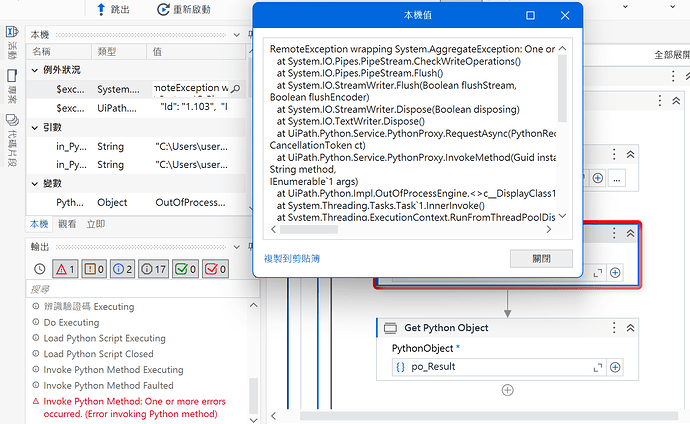Hello, I’m a student who is currently learning UiPath. I found a tutorial on this method at GitHub - YenLinWu/RPA_UiPath: RPA(Robotic Process Automation) UiPath 實戰開發範例, but I’m facing an issue with “Invoke Python Method: One or more errors occurred. (Error invoking Python method).” I’m not sure how to resolve it
The file that he’s reading can be used in VS Code but not in UiPath. He created a virtual environment using Anaconda and confirmed that the paths are correct. He has also searched for relevant articles but is still encountering this issue.
Since I am a new user, I cannot upload files. Here is the content of the code:
import os
import numpy as np
from pathlib import Path
import tensorflow as tf
from tensorflow.keras import backend as K
from tensorflow.keras import layers
from tensorflow.keras.models import Model, load_model
os.environ[‘TF_FORCE_GPU_ALLOW_GROWTH’] = ‘true’
def CRNN( ImageFolderPath, ImageName ):
# Pretained model path
model_path = "CRNN.h5"
# Get list of all the captcha testing images
data_dir = Path( ImageFolderPath )
Image = list(map(str, list(data_dir.glob(ImageName))))
# Mapping characters to integers
Characters = {'0','1','2','3','4','5','6','7','8','9'}
char_to_num = layers.experimental.preprocessing.StringLookup(
vocabulary=sorted(list(Characters)), num_oov_indices=0, mask_token=None )
# Mapping integers back to original characters
num_to_char = layers.experimental.preprocessing.StringLookup(
vocabulary=char_to_num.get_vocabulary(), mask_token=None, invert=True )
def encode_single_sample( img_path ):
# 1. Read image
img = tf.io.read_file( img_path )
# 2. Decode and convert to grayscale
img = tf.io.decode_png( img, channels=1 )
# 3. Convert to float32 in [0, 1] range
img = tf.image.convert_image_dtype( img, tf.float32 )
# 4. Resize to the desired size
img = tf.image.resize( img, [32,104] )
# 5. Transpose the image because we want the time dimension to correspond to the width of the image,
# i.e., shape = (img_weight,img_height,1).
img = tf.transpose( img, perm=[1,0,2] )
return { "image": img }
# Create validation dataset object
validation_dataset = tf.data.Dataset.from_tensor_slices( (np.array(Image)) )
validation_dataset = ( validation_dataset.map(
encode_single_sample, num_parallel_calls=tf.data.experimental.AUTOTUNE
).batch(1).prefetch(buffer_size=tf.data.experimental.AUTOTUNE)
)
# Build an custom endpoint layer of the pretrained model.
class CTCLayer( layers.Layer ):
def __init__( self, name=None, **kwargs ):
super().__init__( name=name )
self.loss_fn = K.ctc_batch_cost
def call( self, y_true, y_pred ):
batch_len = tf.cast( tf.shape(y_true)[0], dtype='int64' )
input_length = tf.cast( tf.shape(y_pred)[1], dtype='int64' )
label_length = tf.cast( tf.shape(y_true)[1], dtype='int64' )
input_length = input_length*tf.ones( shape=(batch_len,1), dtype='int64' )
label_length = label_length*tf.ones( shape=(batch_len,1), dtype='int64' )
loss = self.loss_fn( y_true, y_pred, input_length, label_length )
self.add_loss(loss)
return y_pred
model = load_model( model_path, custom_objects={'CTCLayer': CTCLayer} )
# Get the prediction model by extracting layers till the output layer
prediction_model = Model( model.get_layer( name='Input' ).input, model.get_layer( name='Softmax' ).output, name='Prediction' )
# A utility function to decode the output of the network
def decode_batch_predictions( pred ):
input_len = np.ones(pred.shape[0]) * pred.shape[1]
# Use greedy search. For complex tasks, you can use beam search
results = K.ctc_decode( pred, input_length=input_len, greedy=True )[0][0][:,:4]
# Iterate over the results and get back the text
output_text = []
for res in results:
res = tf.strings.reduce_join(num_to_char(res)).numpy().decode('utf-8')
output_text.append(res)
return output_text
for batch in validation_dataset.take(1):
batch_image = batch['image']
pred = prediction_model.predict(batch_image)
pred_text = decode_batch_predictions(pred)
return pred_text[0]




